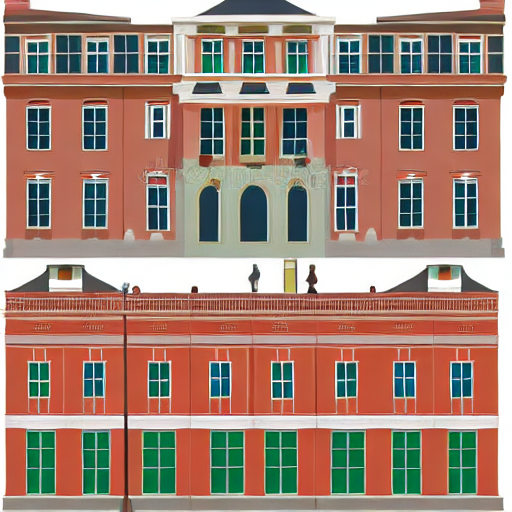
Post written by \ Yasser Mokhtar Osman 09/22/2023
Hello ECHO Friends
We brought you a new Subject for today is
Exploring the Evolution of Architectural Design Through History
Overview
Introduction to architectural design
Architectural design is a fascinating field that has evolved significantly throughout history. From the ancient civilizations of Egypt and Mesopotamia to the magnificent structures of the Renaissance and the modern skyscrapers of today, architecture has always been a reflection of society and its values. In this article, we will explore the key milestones in the evolution of architectural design, examining the different styles, techniques, and influences that have shaped the built environment. By understanding the origins and development of architectural design, we can gain a deeper appreciation for the buildings and structures that surround us and the impact they have on our lives.
Importance of studying architectural design
The study of architectural design is of utmost importance as it allows us to understand the evolution and development of human civilization. Architecture not only shapes our physical environment but also reflects the cultural, social, and economic values of a society. By studying architectural design, we can gain insights into the historical context, technological advancements, and artistic movements that have influenced the creation of iconic structures throughout history. Furthermore, understanding architectural design helps us appreciate the significance of preserving architectural heritage and promotes sustainable and innovative approaches to future designs. Overall, studying architectural design provides a comprehensive understanding of our built environment and its impact on our lives.
Brief history of architectural design
Architectural design has evolved significantly throughout history, reflecting the cultural, social, and technological changes of each era. The brief history of architectural design provides a fascinating glimpse into the development of various architectural styles and techniques. From the ancient Egyptian and Greek civilizations to the Renaissance and modernism, each period has left its mark on the built environment. This paragraph will delve into the key milestones and influential architects that have shaped the course of architectural design over the centuries.
Ancient Architecture

Introduction to ancient architectural design
In this article, we will delve into the fascinating world of architectural design throughout history. We will start by exploring the ancient architectural designs that laid the foundation for the magnificent structures we see today. The introduction to ancient architectural design will provide a glimpse into the innovative techniques and artistic expressions that defined the architectural landscape of ancient civilizations. From the grand pyramids of Egypt to the intricate temples of Greece, we will uncover the rich history and evolution of architectural design from its earliest beginnings.
Key characteristics of ancient architecture
Ancient architecture is characterized by several key characteristics that have shaped the evolution of architectural design throughout history. One of the most notable characteristics is the use of natural materials such as stone, wood, and clay, which were readily available and durable. Another key characteristic is the emphasis on grandeur and monumentality, with structures often designed to impress and awe. Additionally, ancient architecture often incorporated intricate decorative elements, such as carvings, sculptures, and murals, showcasing the skill and craftsmanship of the builders. Lastly, ancient architecture was influenced by the cultural, religious, and societal beliefs of the time, resulting in unique and distinct architectural styles across different civilizations. Understanding the key characteristics of ancient architecture is crucial in comprehending the foundation upon which modern architectural design has been built.
Famous examples of ancient architectural design
Ancient architectural design has left behind numerous famous examples that continue to awe and inspire people today. One such example is the Great Pyramids of Giza in Egypt, which were built as tombs for the pharaohs. These massive structures showcase the incredible engineering skills and precision of the ancient Egyptians. Another iconic example is the Parthenon in Athens, Greece, a temple dedicated to the goddess Athena. Its impressive columns and intricate sculptures are a testament to the skill and creativity of the ancient Greeks. The Colosseum in Rome, Italy, is yet another famous example of ancient architectural design. This amphitheater, known for its grandeur and ability to host various events, serves as a reminder of the advanced engineering techniques employed by the Romans. These famous examples of ancient architectural design not only reflect the cultural and historical significance of their respective civilizations but also demonstrate the enduring impact of architectural achievements throughout history.
“الاجتهاد والاتزام والمثابرة وحب العمل هو احد اسباب نجاح اي شخص في مجال الاعمال “
ياسر مختار عثمان
Medieval Architecture

Introduction to medieval architectural design
Medieval architectural design is a fascinating subject that showcases the evolution of architectural styles and techniques during the Middle Ages. This period, spanning from the 5th to the 15th century, saw the rise of magnificent castles, cathedrals, and fortifications that still stand as testaments to the ingenuity and craftsmanship of the time. The architectural design of the medieval era was heavily influenced by religious beliefs, with Gothic architecture emerging as a dominant style characterized by pointed arches, ribbed vaults, and flying buttresses. This introduction to medieval architectural design aims to delve deeper into the key characteristics and influences that shaped this remarkable period in architectural history.
Influence of religion on medieval architecture
The influence of religion on medieval architecture cannot be overstated. During this period, religion played a central role in the lives of people, and it heavily influenced their beliefs, values, and way of life. As a result, religious institutions, such as churches and cathedrals, became the focal points of architectural design. The architecture of these religious structures was characterized by grandeur, with soaring spires, intricate stained glass windows, and elaborate sculptures. The use of religious symbols and motifs was also prevalent, further emphasizing the connection between religion and architecture. Overall, the influence of religion on medieval architecture was profound, shaping the design and purpose of buildings during this era.
Notable features of medieval architectural design
Medieval architectural design is characterized by a number of notable features that have left a lasting impact on the field. One of the key elements of medieval architecture is the use of pointed arches, which replaced the rounded arches of the Romanesque period. These pointed arches not only added a sense of height and grandeur to the buildings but also allowed for the construction of larger and more intricate windows. Another distinctive feature of medieval architecture is the use of ribbed vaults, which provided structural support and allowed for the creation of soaring ceilings. Additionally, medieval architects often incorporated elaborate stone carvings and sculptures into their designs, showcasing their craftsmanship and religious devotion. Overall, the notable features of medieval architectural design reflect the ingenuity and artistic expression of the time, leaving a lasting legacy for future generations.
Renaissance Architecture

Introduction to Renaissance architectural design
The Renaissance period, which spanned from the 14th to the 17th century, marked a significant shift in architectural design. During this time, there was a renewed interest in the classical architectural styles of ancient Greece and Rome. Architects and designers began to incorporate elements such as columns, arches, and domes into their buildings, creating a sense of grandeur and elegance. The use of symmetry and proportion became key principles in Renaissance architectural design, resulting in harmonious and balanced structures. This period also saw the emergence of influential architects such as Filippo Brunelleschi and Andrea Palladio, who played a pivotal role in shaping the architectural landscape of the time. The Introduction to Renaissance architectural design provides a fascinating glimpse into the evolution of architectural styles and the impact of this period on the built environment.
Revival of classical elements in Renaissance architecture
The Renaissance period marked a significant revival of classical elements in architectural design. Inspired by the ancient Greek and Roman civilizations, architects during this time sought to recreate the grandeur and elegance of classical architecture. They incorporated elements such as columns, arches, and domes into their designs, bringing a sense of harmony and proportion to their structures. The revival of classical elements in Renaissance architecture not only reflected a renewed interest in the past but also showcased the artistic and intellectual achievements of the era. This period witnessed the construction of iconic buildings such as the Florence Cathedral and the St. Peter’s Basilica, which continue to inspire architects and enthusiasts to this day.
Impact of Renaissance architecture on future designs
The Impact of Renaissance architecture on future designs is significant. During the Renaissance period, there was a renewed focus on classical architecture and a shift towards a more human-centered approach to design. This period saw the emergence of new architectural elements and techniques, such as the use of perspective, symmetry, and proportion. These innovations in architectural design had a lasting impact on future designs, shaping the way buildings were constructed and influencing the development of architectural styles in the centuries to come. The Renaissance also brought about advancements in engineering services, as architects and engineers worked together to create more ambitious and complex structures. The integration of engineering principles into architectural design paved the way for the construction of iconic buildings and landmarks that still stand today. The influence of Renaissance architecture can be seen in various architectural styles throughout history, demonstrating its enduring impact on the field of architecture.
Image Related




Modern Architecture

Introduction to modern architectural design
Modern architectural design is a fascinating field that has undergone significant evolution throughout history. It is characterized by its emphasis on functionality, simplicity, and the use of innovative materials and construction techniques. This introduction aims to provide an overview of the key principles and influences that have shaped modern architectural design. From the advent of the Industrial Revolution to the rise of iconic architects such as Frank Lloyd Wright and Le Corbusier, this paragraph will explore the major milestones and movements that have contributed to the development of modern architectural design.
Influence of technological advancements on modern architecture
Influence of technological advancements on modern architecture is undeniable. The rapid development of technology has revolutionized the way architects design and construct buildings. With the advent of computer-aided design (CAD) software and advanced building materials, architects now have the ability to create innovative and complex structures that were once unimaginable. Moreover, technological advancements in construction techniques have made it possible to build taller, stronger, and more sustainable buildings. From the use of 3D printing to the integration of smart technology, technology has become an integral part of modern architectural design, shaping the way we live and interact with our built environment.
Key principles of modern architectural design
Modern architectural design is characterized by several key principles that have evolved over time. These principles include simplicity, functionality, and sustainability. Architects strive to create designs that are clean and minimalistic, with a focus on functionality and practicality. Additionally, modern architecture places a strong emphasis on sustainability, with an aim to reduce the environmental impact of buildings. This includes the use of eco-friendly materials, energy-efficient systems, and incorporating green spaces into the design. By adhering to these key principles, modern architectural design has transformed the way we perceive and interact with the built environment.
Conclusion
Summary of the evolution of architectural design
The evolution of architectural design can be traced back to ancient civilizations such as Egypt, Mesopotamia, and Greece. These early architectural styles were characterized by monumental structures, intricate detailing, and a focus on religious and political symbolism. As societies progressed, architectural design evolved to reflect changing cultural, social, and technological influences. The Renaissance period saw a revival of classical architecture, while the Industrial Revolution brought about innovative materials and construction techniques. In the 20th century, architects embraced modernism and experimented with new forms and materials. Today, architectural design continues to evolve, with a focus on sustainability, technology integration, and the creation of spaces that promote well-being and community.
Importance of studying architectural design history
Studying architectural design history is of utmost importance as it provides us with valuable insights into the evolution of architectural styles and techniques over time. By understanding the past, we can better appreciate the present and make informed decisions about the future. Moreover, studying architectural design history allows us to learn from the successes and failures of previous generations, enabling us to create innovative and sustainable designs that stand the test of time. It also helps us understand the cultural, social, and political contexts in which these designs were created, giving us a deeper understanding of our built environment. Overall, the study of architectural design history is essential for architects, designers, and enthusiasts alike, as it enriches our understanding of the discipline and inspires us to push the boundaries of what is possible.
Future trends in architectural design
In recent years, the field of architectural design has witnessed exciting developments and innovative approaches. As we look towards the future, there are several trends that are expected to shape the architectural landscape. One of the key trends is the integration of sustainable design principles, with a focus on energy efficiency and environmental conservation. Architects are increasingly incorporating renewable materials and technologies into their designs, creating buildings that are not only aesthetically pleasing but also environmentally friendly. Another important trend is the use of advanced technology in the design process. With the advent of virtual reality, architects can now create immersive experiences for their clients, allowing them to visualize and interact with the proposed designs before construction even begins. Additionally, the concept of adaptable and flexible spaces is gaining popularity, as architects strive to create buildings that can easily adapt to changing needs and functions. These future trends in architectural design hold great promise for creating sustainable, technologically advanced, and adaptable structures that will shape the cities of tomorrow.
من فضلك شارك الموضوع مع الاخرين
Please Share the post with others
- Architectural Landmarks
- Architectural


